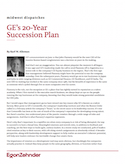GE’s 20-Year Succession Plan
GE’s announcement on June 12 that John Flannery would be the next CEO of the massive Boston-based conglomerate was a decision 20 years in the making.
And that’s not an exaggeration. You can almost pinpoint the moment it all began: It was 1997 and GE’s leadership made the call to send Flannery off to Argentina to a senior role in the company’s GE Equity business in the region. That’s the first sign that management believed Flannery might have the potential to run the company someday. Over the subsequent years, Flannery would go on to run businesses in Japan and India in wide-ranging divisions such as GE Commercial Finance, GE Healthcare, and GE India. The new CEO-in-waiting has worked at the same company since 1987, but his breadth of experience is the same as someone who’s cycled through five or more companies over his career.
Flannery is the rule, not the exception at GE–a place that has rightly earned its reputation as a talent academy. When I first started in the executive search business, we always kept an eye on the people running the top businesses at the company, knowing that they would make strong potential candidates for CEO jobs.
But I would argue that management gurus have missed one key reason why GE is known as a talent factory. Most point to GE’s Crotonville, the company’s leadership institute and what the Boston Globe called in a February article the company’s “heart,” as the secret sauce to its leadership success. It’s true that Crotonville has been at the core of much of the company’s reputation for developing strong talent. But there’s another, less understood piece of the puzzle: rotation through a wide range of roles and assignments. And that is what Flannery’s expertise represents.
Here’s why that’s important: In a rapidfire era when every company is at risk of being disrupted, the way to succeed is to have a broad lens. Meaningful rotations and stretch roles, in addition to feedback and coaching, are the best ways to build agile, curious leaders. In a recent study we conducted, 40% of leaders cited rotation as key to their success, with 71% citing stretch assignments as absolutely critical. A broader perspective, along with leadership development support to fully realize an executive’s inherent potential, will help new leaders embrace the inevitable change that awaits them.
The importance of rotation as a development tool may seem obvious, but shockingly few companies actually practice it. Instead they keep people in the same geography, division, or function rather than encouraging them to move into something new. It’s easy to see how this can happen. Why would you move someone into a new role if they’re really good at their current one and are passionate about what they do? It’s scary, and there’s always the risk of failure. Even at GE, rotation has been bumpy. In the past, the company moved executives so quickly that they didn’t have to live with the real-life results of their decisions. But that’s no longer the case, as evidenced by Flannery spending three or more years in each position.
GE has been successful where others have failed by realizing that what it makes is not a product but talent. In my experience, this is especially rare for an industrial company. For decades, human resources arguably has been the strongest function in GE. Executives don’t just pay lip service to the importance of having a talent pipeline. They actually practice it, making sure managers know they won’t move up if they haven’t developed multiple successors. As a result, GE typically hasn’t had to fill essential senior roles externally.
That said, the handoff from Jeff Immelt–also a product of the company’s talent academy–to Flannery likely didn’t occur exactly on GE’s timeline. Immelt might have served 20 years rather than his current 16 if the company had not been facing pressure from an activist investor–and if the stock had performed better. (Whether a 20-year tenure is even appropriate is a topic for another day.)
But when the moment of transition came, it worked as it was supposed to. The company maintained confidentiality, made it a multi-year process, and scanned the external market. The board of directors had multiple internal candidates with different skillsets from which to choose, meaning it could pick the right person for this particular moment in the company’s history.
Granted, John Flannery is a dying breed–a company man who has spent his working life toiling at one institution. In an age of job hopping, it may be impossible for the next generation of GE leadership to emulate this kind of development model. But let’s make sure we don’t lose what Flannery’s rise has come to represent: a calm, well-planned transition of power decades in the making.
Read more from Karl Alleman’s Midwest Dispatches series – click here.
Karl W. Alleman leads the U.S. practice of Egon Zehnder, a global executive search and leadership consulting firm.
Contact Karl at: karl.alleman@egonzehnder.com or +1 312 260 8860






